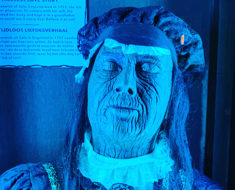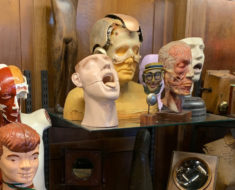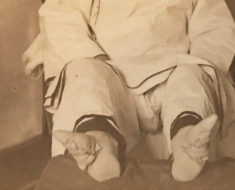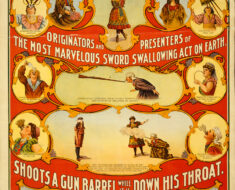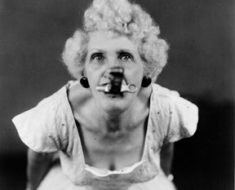A rare and unusual figure in sideshow history is the Ossified Man. Such men can do nothing more than lie still, as their joints have completely stiffened due to a fusion of the bones. This condition is called ankylosis.
One of the early sideshow performers to exhibit his stiffened body was Jonathan R. Bass. He was born healthy in 1830 in Cambria, a town in western New York. But when rheumatism struck at the age of seven things began to change. The first case was a minor attack, but he suffered another two years later and was stiff for three days. By age sixteen, his feet were stiffened and left him unable to stand or leave home for three months. Eventually the rheumatism led to ankylosis of all his joints.
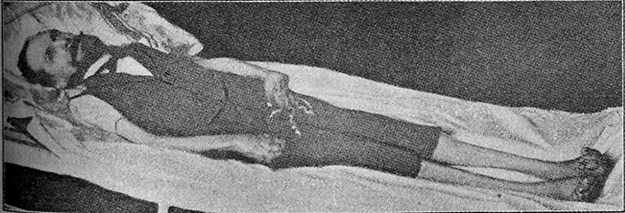
Jonathan R. Bass, from Anomalies and Curiosities of Medicine
The International Journal of Surgery claimed: “All the muscles, tendons and joints have been converted into solid bone; he is incapable of any motion whatever, being a prisoner in his own frame.”
He ate by sucking food into his mouth and swallowing it whole. A specially made bed helped him sleep at night. In general, he did not suffer from pain.
After the passing of his mother and one of his brothers, he decided to get out in the world and make a living. Unable to do anything but lie in his bed, he chose to exhibit his stone-like, emaciated body. Weighing just 75 pounds, he was billed as both the Ossified Man and the Living Skeleton. A manager scheduled his tour starting in Niagara Falls and traveling through the country.
Life was relatively good, until 1892, when Bass became frustrated with his weekly $25 earnings. So he fired his manager and hired his remaining brother. Later that year, he reportedly caught pneumonia while on display at Huber’s 14th Street Museum in New York City. He passed away shortly after returning home.
One of the more bizarre ossified men was Ivannow Wladislaus Von Dziarski-Orloff. In addition to being stiff, he was transparent.
Orloff was born in 1864 in Budapest, Hungary and began losing his strength by the age of 14. As the years went on his limbs weakened and began to curl. Trapped in such an strange position, Orloff could have earned a living from his body’s unusual shape alone. But it was his extraordinary translucency that made him truly unique. Blood could be seen circulating through his body. In an even more amazing stunt, a light shining on his chest made it possible to read a newspaper held up to his back.
Orloff exhibited his odd body at the Royal College of Medicine in Berlin for three years, becoming known as Count Orloff, The Only Living Transparent and Ossified Man. Anomalies and Curiosities of Medicine claimed his transparency was “due to porosity of the bones and deficiency of the overlying tissues.”
Orloff remained in his ossified and transparent condition until his passing in 1904.
When Robert Ripley returned to the 1934 World’s Fair with his second Odditorium, an ossified man was one of his star attractions.
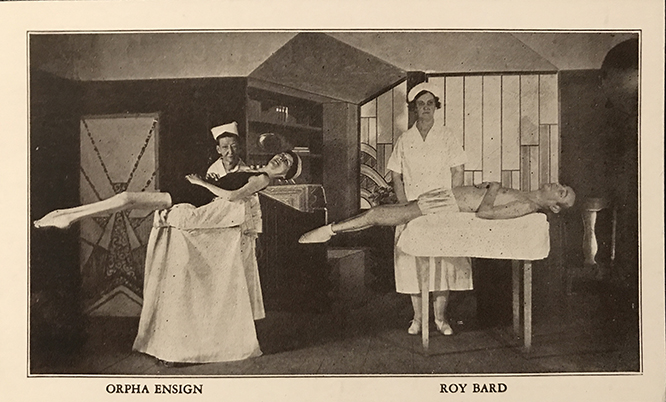
Roy Bard and Orphan Ensign, Ossified People at the 1934 Ripley’s Odditorium. Postcard from the Marc Hartzman collection.
Roy Bard, was born in Bryan, Ohio on April 1, 1889 and never suspected he would one day end up in a sideshow. Bard was completely normal until the age of 24. A stiffness began in his left hip and progressed for four years until his entire body was completely stiff. Bard had become much like a board, lying flat in the same position. This put an end to his career as a telephone lineman, but eventually opened the door to the Odditorium. In a souvenir Odditorium postcard collection from the World’s Fair, Ripley described Bard as being “rigid as a rock.” He was said to be otherwise healthy.
According to a reporter who interviewed several of Ripley’s performers during the World’s Fair, he accepted his condition. “Believe it or not I am happy,” Bard said, using a phrase that surely made Ripley smile.
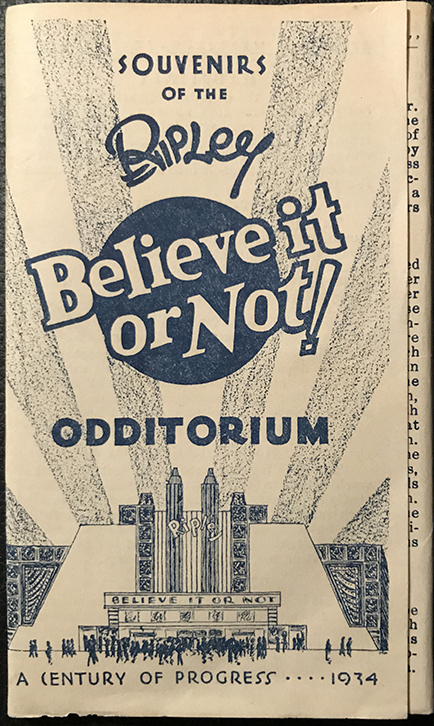
1934 Ripley’s Odditorium souvenir pamphlet with postcards. From the Marc Hartzman collection.
The Ossified Man was joined at the Odditorium by an Ossified Woman, Orpha Ensign. Sadly, she couldn’t see her male counterpart because in addition to suffering from ankylosis, she was blind. Ripley claimed that despite these difficult conditions, she was a successful owner of a small tourist hotel in Panama City, Florida. “Although her body is hard as stone, her heart is soft and kind,” Ripley wrote in the souvenir pamphlet.
While Ensign exhibited her ossified body, another young woman was following in her stiffened footsteps. Dolly Regan, the Ossified Girl, was born in Saskatoon, Canada in 1919. Muscular dystrophy paired with ankylosis soon paralyzed her joints. At 14, she stood 4 feet, 1 inch, but as her body grew more stone-like she shrunk down to 3 feet, 9 inches.
Regan could neither stand nor walk. However, she had command of a few fingers, which helped her control an electric wheelchair. She was also able to hold a specially-designed, multifunctional stick, enabling her to reach to things, smoke cigarettes, and poke people as needed.
Regan’s sideshow career started unexpectedly. In 1942, she happened to be selling raffle tickets near a visiting sideshow. It was the first time she’d seen such a show, so she and a friend decided to explore. A manager soon discovered her and offered her $50 to be his “stone lady.” She accepted.
Suddenly, she was making money and even found love. Several times. Regan would eventually marry three times (a juggler, a ride foreman, and a magician/sideshow manager).
Regan’s career lasted decades. Though she had been known as the Ossified Girl, longtime showman Bobby Reynolds later renamed her the Half Lady-Half Baby. He described her as such: “From the waistline up, a perfectly normal, beautiful well-developed girl. But from the waistline down, she has the body of an infant!” Regan’s new billing proved successful in her own Single-O show.
Regan was always happy to support herself. Her mind was sharp, and she never wanted to be confined or put away simply because of her body’s condition. She remained active until passing away in 1994 at the age of 75.
The information on Roy Bard was originally published on my site, American Sideshow Blowoff.
The other stories, with the exception of Orpha Ensign, are edited from my book, American Sideshow. You can see more of it here, or better yet, buy it from Amazon.

